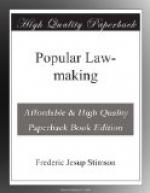[Footnote 1: We may divide monopolies into legal, geographical, and de facto, or “virtual” monopolies—phrases which sufficiently describe themselves.]
We thus find that the earliest legislation regulating rates was that of the States. It was thirteen years after the Iowa statute above referred to that the Interstate Commerce Act was passed, which was supposed to give a power—afterward denied by our Supreme Court—to the Interstate Commerce Commission to fix rates. It certainly did give them power to find, upon complaint, what was a reasonable rate, which was prima facie evidence in case of appeal. In hundreds of cases actual rates were complained of, in probably many more discrimination was complained of, and, according to Mr. Meyer, the commission was found by the Supreme Court to have decided rightly about half the time. In 1903 came the intelligent Elkins Bill against discrimination, which merely re-enacts the common law, and up to within two or three years has proved the only really effective measure of controlling the rates themselves. In 1906 came the Hepburn Act under Roosevelt, giving general power to the commission to fix rates upon complaint, to make joint rates, extending the statute to the oil pipe-lines, express companies, and sleeping-car companies, and going to the verge of the Constitution in an effort to provide that rates fixed by the commission should take immediate effect. So far as most recent decisions go, however, this great statute has not altered the position of the Supreme Court of the United States as to the constitutional necessity of a reasonable return to the carrier, and perhaps the cardinal question remains to be decided, whether such rate-making power is legislative, and, if so, may under the Federal Constitution be delegated by Congress to any board. Congress merely proclaims that the rates shall be reasonable




